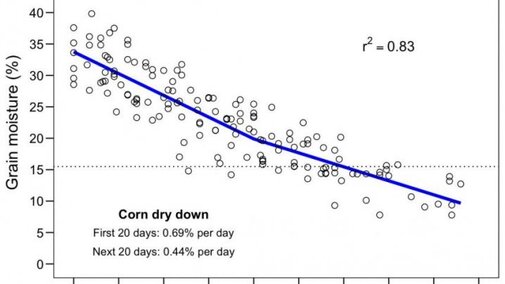How fast do soybeans and corn dry down in the field? That's the question Iowa State University researchers examined in research conducted near Ames over the last three years in corn and soybean fields. Researchers Rafael Martinez-Feria, graduate student, Mark Licht, assistant professor, and Sotirios Archontoulis, assistant professor, report on their findings in this week’s Iowa State University Integrated Crop Management News. Following is further information from the articles, graphs of the researchers' data, reprinted here with permission, and links to the full articles.
Soybean
Knowing current soybean moisture levels and the rate at which soybeans naturally dry down in the field can help with scheduling harvest and planning for storage. Two stories in the Sept. 15 CropWatch addressed the economics of selling soybeans at 13% moisture and recommendations for harvesting at that moisture level, when stems may still be green (see box). When trying to achieve optimum moisture, drying down soybeans as much as possible in the field can help save the cost of energy for bin drying. Knowing how long dry-down might take in the field is one consideration when scheduling harvest of individual fields.
“How Fast do Soybeans Dry Down in the Field?,” an article by Rafael Martinez-Feria, Sotirios Archontoulis, and Mark Licht in this week’s Iowa State University Integrated Crop Management News, looks at this topic. The authors chart the dry-down phase from R7 to R8, based on data from three years of post-R7 seed moisture observations on four MG variety groups grown in four planting dates near Ames, Iowa. R7 marks the beginning of maturity and is when one normal pod on the main stem has reached its mature pod color. R8 is full maturity when 95% of the pods have reached their full mature color. Summer to fall transition in daily temperature is the key driver of soybean development from R6 to R7.
The authors write: “During the first 12 days after maturity, the average dry down rate was 3.2 percent per day, which is about five times faster than that of corn. After that period, the dry down rate significantly slows down or stops completely, stabilizing at about 13 percent moisture.”

Also see
Corn
Calculating corn dry down in the field can be helpful in determining when fields and hybrids will reach maturity and scheduling order of fields for harvest. The ISU research offers an insight into how corn dries down in the field.
Here's how the three researchers conducted their study in corn: "From 2014 through 2016 we collected corn ears from a central Iowa field that had four dates of planting and four hybrid maturities. Corn ears were collected on a weekly interval in September and October. Our data indicates that the average dry down rate during the entire dry down period is 0.58% per day (Figure 2). However, this drying rate is not constant. During the first 20 days, moisture is lost at a rate of 0.69% per day, while the next 20 days it drops to 0.44% per day."
"Based on this dataset, corn field dry down to 15.5% moisture may take up to 35 days when kernel moisture at maturity is high (38-36%) while when it is low (30-28%) it may take about 25 days. It is important to note that these estimates are meant to represent normal fall conditions. Low temperatures (oF) and/or high humidity (>90% relative humidity) for prolonged periods (>2 or 3 days) can significantly delay dry down.


